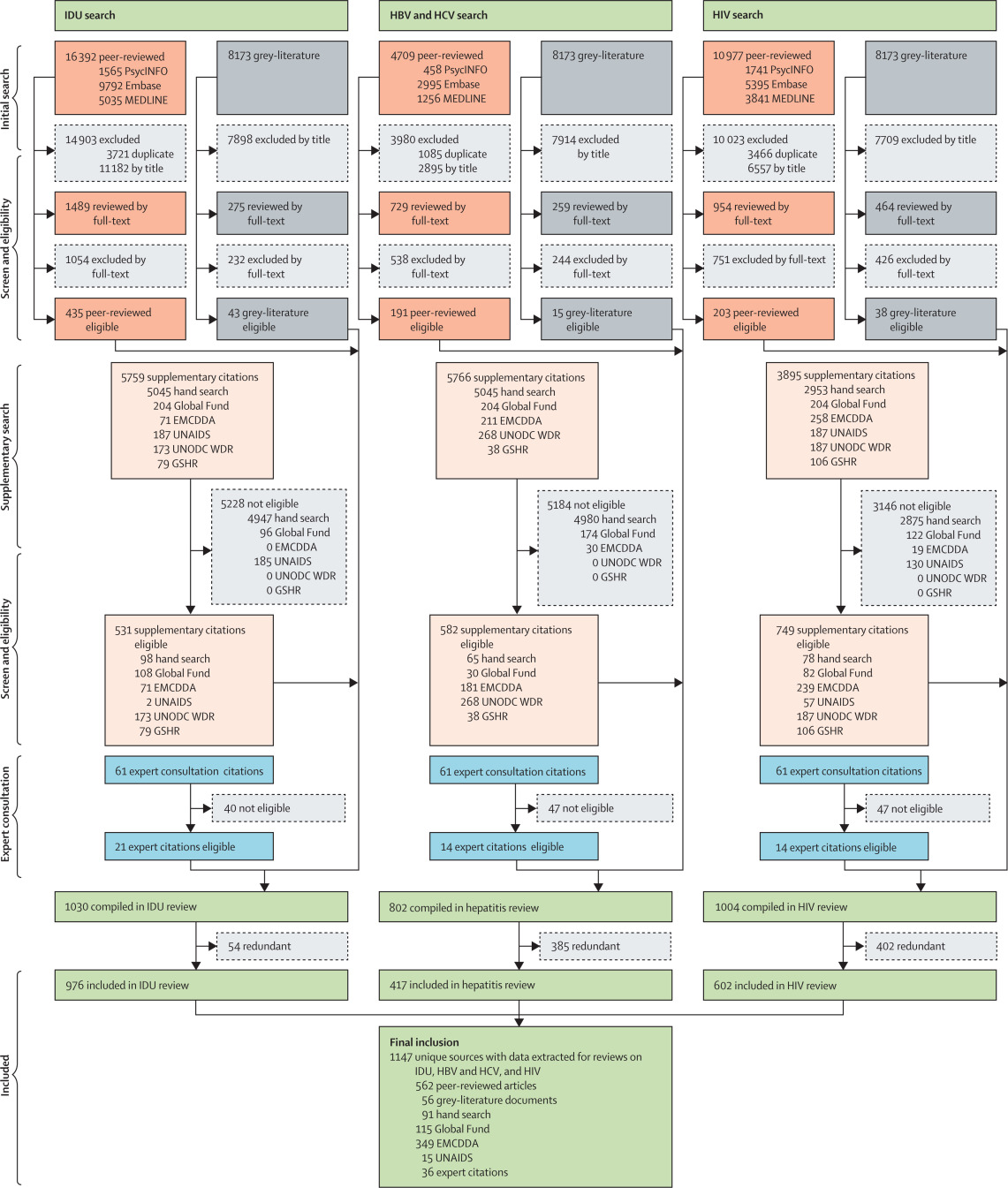The Lancet Global Health ( IF 19.9 ) Pub Date : 2017-10-23 , DOI: 10.1016/s2214-109x(17)30375-3 Louisa Degenhardt , Amy Peacock , Samantha Colledge , Janni Leung , Jason Grebely , Peter Vickerman , Jack Stone , Evan B Cunningham , Adam Trickey , Kostyantyn Dumchev , Michael Lynskey , Paul Griffiths , Richard P Mattick , Matthew Hickman , Sarah Larney

|
Background
Sharing of equipment used for injecting drug use (IDU) is a substantial cause of disease burden and a contributor to blood-borne virus transmission. We did a global multistage systematic review to identify the prevalence of IDU among people aged 15–64 years; sociodemographic characteristics of and risk factors for people who inject drugs (PWID); and the prevalence of HIV, hepatitis C virus (HCV), and hepatitis B virus (HBV) among PWID.
Methods
Consistent with the GATHER and PRISMA guidelines and without language restrictions, we systematically searched peer-reviewed databases (MEDLINE, Embase, and PsycINFO; articles published since 2008, latest searches in June, 2017), searched the grey literature (websites and databases, searches between April and August, 2016), and disseminated data requests to international experts and agencies (requests sent in October, 2016). We searched for data on IDU prevalence, characteristics of PWID, including gender, age, and sociodemographic and risk characteristics, and the prevalence of HIV, HCV, and HBV among PWID. Eligible data on prevalence of IDU, HIV antibody, HBsAg, and HCV antibody among PWID were selected and, where multiple estimates were available, pooled for each country via random effects meta-analysis. So too were eligible data on percentage of PWID who were female; younger than 25 years; recently homeless; ever arrested; ever incarcerated; who had recently engaged in sex work, sexual risk, or injecting risk; and whose main drugs injected were opioids or stimulants. We generated regional and global estimates in line with previous global reviews.
Findings
We reviewed 55 671 papers and reports, and extracted data from 1147 eligible records. Evidence of IDU was recorded in 179 of 206 countries or territories, which cover 99% of the population aged 15–64 years, an increase of 31 countries (mostly in sub-Saharan Africa and the Pacific Islands) since a review in 2008. IDU prevalence estimates were identified in 83 countries. We estimate that there are 15·6 million (95% uncertainty interval [UI] 10·2–23·7 million) PWID aged 15–64 years globally, with 3·2 million (1·6–5·1 million) women and 12·5 million (7·5–18·4 million) men. Gender composition varied by location: women were estimated to comprise 30·0% (95% UI 28·5–31·5) of PWID in North America and 33·4% (31·0–35·6) in Australasia, compared with 3·1% (2·1–4·1) in south Asia. Globally, we estimate that 17·8% (10·8–24·8) of PWID are living with HIV, 52·3% (42·4–62·1) are HCV-antibody positive, and 9·1% (5·1–13·2) are HBV surface antigen positive; there is substantial geographic variation in these levels. Globally, we estimate 82·9% (76·6–88·9) of PWID mainly inject opioids and 33·0% (24·3–42·0) mainly inject stimulants. We estimate that 27·9% (20·9–36·8) of PWID globally are younger than 25 years, 21·7% (15·8–27·9) had recently (within the past year) experienced homelessness or unstable housing, and 57·9% (50·5–65·2) had a history of incarceration.
Interpretation
We identified evidence of IDU in more countries than in 2008, with the new countries largely consisting of low-income and middle-income countries in Africa. Across all countries, a substantial number of PWID are living with HIV and HCV and are exposed to multiple adverse risk environments that increase health harms.
Funding
Australian National Drug and Alcohol Research Centre, Australian National Health and Medical Research Council, Open Society Foundation, World Health Organization, the Global Fund, and UNAIDS.
中文翻译:

全球注射吸毒率和社会人口统计学特征以及注射吸毒者中HIV,HBV和HCV的患病率:多阶段系统回顾
背景
共用用于注射毒品的设备(IDU)是造成疾病负担的重要原因,并且是血液传播病毒传播的一个原因。我们进行了一项全球多阶段的系统评估,以确定15-64岁人群中IDU的患病率。注射毒品者的社会人口统计学特征和危险因素(PWID);以及PWID中HIV,丙型肝炎病毒(HCV)和乙型肝炎病毒(HBV)的患病率。
方法
符合GATHER和PRISMA准则且无语言限制,我们系统地搜索了同行评审数据库(MEDLINE,Embase和PsycINFO;自2008年以来发表的文章,2017年6月的最新搜索),搜索了灰色文献(网站和数据库, (2016年4月至8月之间),并将数据请求分发给国际专家和机构(请求于2016年10月发送)。我们搜索了有关IDU患病率,PWID特征(包括性别,年龄,社会人口统计学和风险特征)以及PWID中HIV,HCV和HBV患病率的数据。选择有关PWID中IDU,HIV抗体,HBsAg和HCV抗体患病率的合格数据,并在可获得多种估计的情况下,通过随机效应荟萃分析汇总每个国家/地区的数据。关于女性PWID百分比的合格数据也是如此;25岁以下;最近无家可归;曾经被捕;曾经被监禁;最近从事过性工作,性风险或注射风险的人;注射的主要药物是阿片类药物或兴奋剂。我们根据之前的全球评论得出了区域和全球估算。
发现
我们审查了55671篇论文和报告,并从1147份符合条件的记录中提取了数据。在206个国家或地区中的179个记录了吸毒者的证据,覆盖15-64岁人口的99%,自2008年进行审查以来,增加了31个国家(主要在撒哈拉以南非洲和太平洋岛屿)。在83个国家/地区确定了患病率估算值。我们估计全球有15·600万(95%不确定区间[UI] 10·2-23·700万)年龄在15-64岁之间的PWID,其中有3·200万(1·6-5·100万)妇女男性有12·5百万(7·5–18·4百万)。性别构成因地点而异:据估计,在北美,女性占PWID的30·0%(95%UI 28·5–31·5),而在大洋洲,女性占33·4%(31·0–35·6)与南亚地区的3·1%(2·1–4·1)相关。在全球范围内,我们估计有17·8%(10·8-24·8)的PWID感染了艾滋病毒,HCV抗体阳性的比例为52·3%(42·4–62·1),HBV表面抗原阳性的比例为9·1%(5·1-13·2);这些级别的地理位置存在很大差异。在全球范围内,我们估计PWID的82·9%(76·6–88·9)主要是注射阿片类药物,而33·0%(24·3–42·0)主要是在注射兴奋剂。我们估计,全球PWID的27·9%(20·9–36·8)年龄小于25岁,最近(过去一年内)有21·7%(15·8–27·9)经历无家可归或不稳定住房,有57·9%(50·5–65·2)有监禁史。
解释
我们发现IDU的证据比2008年更多,新的国家主要由非洲的低收入和中等收入国家组成。在所有国家/地区中,大量的PWID感染了HIV和HCV,并处于会增加健康危害的多种不利风险环境中。
资金
澳大利亚国家毒品和酒精研究中心,澳大利亚国家卫生和医学研究委员会,开放社会基金会,世界卫生组织,全球基金和联合国艾滋病规划署。











































 京公网安备 11010802027423号
京公网安备 11010802027423号